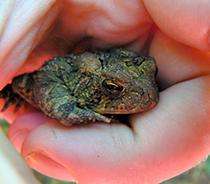Probing Question: What's the difference between frogs and toads?

Frogs and toads: Are there any non-furry creatures more prominent in popular imagination? Bug-eyed and frequently slimy, beloved as well as reviled, they have hopped their way into fairy tales and urban myths, comic books and nursery rhymes, folk songs and animated features. Kissing a frog springs a prince, of course, and touching a toad gives you warts. (Not really.) But how do they differ, one from another? How do we tell frogs and toads apart?
"All toads are frogs," says Bill Hamilton, assistant professor of biology at Penn State’s New Kensington campus. "But not all frogs are toads." True toads, to parse it out, are members of the family Bufonidae, which in turn falls under the order of amphibians commonly called frogs, and known officially as Anura, meaning "without a tail." The order includes some 5,000 species, members of which can be found on every continent except Antarctica. "Frogs are called ‘toads’ when they have a thicker, drier skin," Hamilton adds. A toad’s skin is often covered with bumps and gland openings, which is probably why some people think you can get warts by touching them. Hamilton says that while this is a myth, frogs and toads alike can secrete any number of toxins through their skins.
Having a thick skin permits toads to live away from water longer than most frogs, so you’re more likely to see toads on dry land, he adds. Because they need a different kind of camouflage to live the terrestrial life, toads are often brown in color, which is another way to distinguish them. Toads also prefer to walk where most frogs hop, Hamilton says, but that’s where the differences end and the similarities take over. In addition to the obvious physical resemblance, "Frogs and toads both reproduce and develop in water, both sing and are both are carnivorous," he explains. And most importantly, both frogs and toads are under intense extinction stress from human activities.
"Frogs are some of the most fragile, most environmentally vulnerable species on Earth," says Hamilton, which is why they are a good indicator species for the occurrence of habitat degradation. "They are our ‘mining canaries’ for the entire planet," as he puts it. It’s the same permeable skin that sometimes serves in their defense that makes them more susceptible to environmental trauma and pollution. And the fact that across the world frogs are declining significantly in numbers and diversity is cause for great concern, he said. "Their demise could signify major problems for the global ecosystem."
The touring musical "A Year with Frog and Toad," based on the popular children’s stories, and the current Disney feature "The Princess and the Frog" are some of the latest testaments to these amphibians’ enduring popularity. Says Hamilton, it’s up to us whether future generations of children and adults will continue to have plenty of opportunities to observe and enjoy these captivating creatures. In the end, he said, that’s more important than whether we call a frog a toad or a toad a frog.
Provided by Pennsylvania State University

















